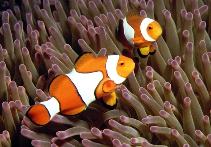| Amphiprion percula (Lacepède, 1802) | ||||
| Family: | Pomacentridae (Damselfishes) | picture (Amper_ur.jpg)
by
Patzner, R.
Map |
||
| Order: | Perciformes (perch-likes) | |||
| Class: | Actinopterygii (ray-finned fishes) | |||
| FishBase name: | Orange clownfish | |||
| Max. size: | 11.0 cm TL (male/unsexed; Ref. 9710) | |||
| Environment: | reef-associated; non-migratory; marine ; depth range 1 - 15 m | |||
| Climate: | tropical; 10°S - 25°S | |||
| Importance: | fisheries: of no interest; aquarium: commercial | |||
| Resilience: | High, minimum population doubling time less than 15 months (Preliminary K and tmax.) | |||
| Distribution: Gazetteer |
Western Pacific: Queensland and Melanesia including northern Great Barrier Reef, northern New Guinea, New Britain, Solomon Islands and Vanuatu. Not known from New Caledonia and the Fiji Islands, although Fowler (1959) recorded it from the latter area. Often confused with Amphiprion ocellaris. | |||
| Diagnosis: | Dorsal spines (total): 9-10; Dorsal soft rays (total): 14-17; Anal spines: 2-2; Anal soft rays: 11-13. Overall orange with three black-bordered vertical white bands. The fins also orange with black edges. Dorsal count of 9 spines (Ref. 48636). | |||
| Biology: | Inhabits lagoon and seaward reefs (Ref. 9710). Each group of fish consists of a breeding pair and 0-4 non-breeders. Within each group there is a size-based hierarchy: the female is largest, the male is second largest, and the non-breeders get progressively smaller as the hierarchy is desceded. If the female dies, the male changes sex and becomes the breeding female, while the largest non-breeder becomes the breeding male. The maintenance of size differences may avoid conflicts, because subordinates do not become a threat to their dominants (Ref. 47841). Appears to occur in shallower depths than A. ocellaris. This species has been reared in captivity (Ref. 35404, 35413, 35420). Associated with the anemones: Heteractis crispa, Heteractis magnifica, and Stichodactyla gigantea (Ref. 5911) | |||
| Red List Status: | Not in IUCN Red List , (Ref. 36508) | |||
| Dangerous: | harmless | |||
| Coordinator: | Allen, Gerald R. | |||
| Main Ref: | Allen, G.R.. 1991. (Ref. 7247) | |||
|
Update | Add | Get XML file | Point data in XML | Common names in XML |
||||